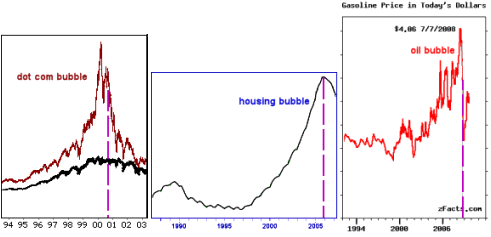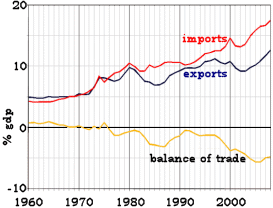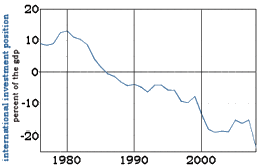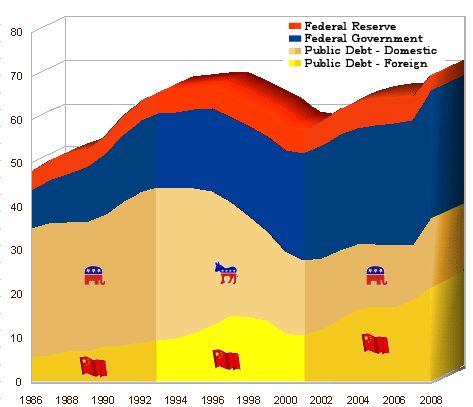| It Is Only a Paper Moon [1933]
|
| Mmm, mm, mm, mm A bubble for a minute Mmm, mm, mm, mm You smile, the bubble has a rainbow in it |
| Say, it’s only a paper moon Sailing over a cardboard sea But it wouldn’t be make-believe If you believed in me… |
In the last year, we’ve learned a lot about "financial bubbles" – situations where values in some Market become inflated and there’s a rush to commerce. Values artificially soar until an inevitable point of absurdity – and then they plummet. Another way to think about financial bubbles is by pondering Alan Greenspan’s term, Irrational Exuberance. Robert Shiller used the quote for a book title, a book about financial bubbles. It’s a version of those situations where the promise of short term gain overwhelms rational long term planning.
 I suppose the paradigm is the Gold Rush mentality that recurrently gripped our country in the 19th century. Hordes of people threw caution to the wind on hearing of a Gold Strike, sold everything they owned, and headed for the Wilderness. A Gold find in Georgia was the stimulus for the Trail of Tears. Custer’s expedition into the Black Hills found Gold and was, in part, responsible for his "Last Stand" and the later Lakota massacre at Wounded Knee. There were thousands of broken lives after Gold was found in California and in the Klondike.
I suppose the paradigm is the Gold Rush mentality that recurrently gripped our country in the 19th century. Hordes of people threw caution to the wind on hearing of a Gold Strike, sold everything they owned, and headed for the Wilderness. A Gold find in Georgia was the stimulus for the Trail of Tears. Custer’s expedition into the Black Hills found Gold and was, in part, responsible for his "Last Stand" and the later Lakota massacre at Wounded Knee. There were thousands of broken lives after Gold was found in California and in the Klondike.
 The Stock Market Crash in 1929 was such a phenom. In the roaring twenties, America discovered the Stock Market and turned it into a gambling casino, ultimately breaking the bank and ushering in a time of unequaled hardship – the 1930s. That Crash was a financial bubble that effected the whole stock market. In our recent history, we’ve had three financial bubbles that afflicted a specific market sector. The "Internet Bubble" came first. When people realized the potential of the Internet, any company involved soared in value. Pretty soon, Internet Companies were being created and sold before they even started operating. Then came the "Housing Bubble." It was more complicated. Financial Deregulation created a situation where risk itself could be traded and a complex system developed that treated mortgages [virtual money] as if it were real money. The collapse of that bubble continues to devastate our economy. The same thing happened with the "Oil Bubble" a bit later. A year ago, our entire market fell, and brought up specters of the 1929 Crash [still does, as a matter of fact]. This notion of the promise of short term reward or solutions overwhelming rational long term thinking is such a feature of human life that we ought to have a Bureau in the government to look out for it – The Ministry of Bubble Detection or The Ponzi Prevention Administration.
The Stock Market Crash in 1929 was such a phenom. In the roaring twenties, America discovered the Stock Market and turned it into a gambling casino, ultimately breaking the bank and ushering in a time of unequaled hardship – the 1930s. That Crash was a financial bubble that effected the whole stock market. In our recent history, we’ve had three financial bubbles that afflicted a specific market sector. The "Internet Bubble" came first. When people realized the potential of the Internet, any company involved soared in value. Pretty soon, Internet Companies were being created and sold before they even started operating. Then came the "Housing Bubble." It was more complicated. Financial Deregulation created a situation where risk itself could be traded and a complex system developed that treated mortgages [virtual money] as if it were real money. The collapse of that bubble continues to devastate our economy. The same thing happened with the "Oil Bubble" a bit later. A year ago, our entire market fell, and brought up specters of the 1929 Crash [still does, as a matter of fact]. This notion of the promise of short term reward or solutions overwhelming rational long term thinking is such a feature of human life that we ought to have a Bureau in the government to look out for it – The Ministry of Bubble Detection or The Ponzi Prevention Administration.

One of the things that Robert Shiller says about financial bubbles is that during their upswing, people just don’t recognize what’s happening. You can actually see that on the Internet. Before the Housing Bubble burst, there are all kinds of articles arguing that the absurd escalation in house values was rational. There’s an article by Nobel Winner Paul Krugman denying outright that the outlandish gas prices weren’t a sign – "But let’s drop all the talk about an oil bubble," he said. Whether that’s wishful thinking or something else isn’t clear, but it’s a solid observation: A bubble isn’t a bubble until it bursts.
The Mother of all Bubbles?
 I spent the weekend periodically poking around in our International dealings over the Bush Years. We know that part of the problem with our financial recovery has to do with jobs. So many have been outsourced that one wonders where the jobs we need will come from. The Balance of Trade doesn’t look so hot either. Looks like we’re much better customers than suppliers. But the one that really grabbed me was something called the Net International Investment Position [NIIP]. What I found out was that almost all of our recently worsening position was
I spent the weekend periodically poking around in our International dealings over the Bush Years. We know that part of the problem with our financial recovery has to do with jobs. So many have been outsourced that one wonders where the jobs we need will come from. The Balance of Trade doesn’t look so hot either. Looks like we’re much better customers than suppliers. But the one that really grabbed me was something called the Net International Investment Position [NIIP]. What I found out was that almost all of our recently worsening position was  from selling Treasuries to foreign governments. Maybe all of you knew that, but I didn’t. Then I started trying to figure out how much of our National Debt was foreign owned. That turned out to be a more difficult task than I imagined because of the complex way our debt is structured. I was finally able to create a graph that showed how much of the Publicly Held National Debt was foreign owned, back to 1986. It was all I could take on a rainy Sunday, so I watched some football and one of those British Mysteries. Here’s the graph again:
from selling Treasuries to foreign governments. Maybe all of you knew that, but I didn’t. Then I started trying to figure out how much of our National Debt was foreign owned. That turned out to be a more difficult task than I imagined because of the complex way our debt is structured. I was finally able to create a graph that showed how much of the Publicly Held National Debt was foreign owned, back to 1986. It was all I could take on a rainy Sunday, so I watched some football and one of those British Mysteries. Here’s the graph again:

[This is a conservative estimate. There’s another more disturbing estimate here]
The United States government is financing its more than trillion-dollar-a-year borrowing with i.o.u.’s on terms that seem too good to be true. But that happy situation, aided by ultralow interest rates, may not last much longer. Treasury officials now face a trifecta of headaches: a mountain of new debt, a balloon of short-term borrowings that come due in the months ahead, and interest rates that are sure to climb back to normal as soon as the Federal Reserve decides that the emergency has passed.
Even as Treasury officials are racing to lock in today’s low rates by exchanging short-term borrowings for long-term bonds, the government faces a payment shock similar to those that sent legions of overstretched homeowners into default on their mortgages. With the national debt now topping $12 trillion, the White House estimates that the government’s tab for servicing the debt will exceed $700 billion a year in 2019, up from $202 billion this year, even if annual budget deficits shrink drastically. Other forecasters say the figure could be much higher.
In concrete terms, an additional $500 billion a year in interest expense would total more than the combined federal budgets this year for education, energy, homeland security and the wars in Iraq and Afghanistan. The potential for rapidly escalating interest payouts is just one of the wrenching challenges facing the United States after decades of living beyond its means.
The surge in borrowing over the last year or two is widely judged to have been a necessary response to the financial crisis and the deep recession, and there is still a raging debate over how aggressively to bring down deficits over the next few years. But there is little doubt that the United States’ long-term budget crisis is becoming too big to postpone…
 The article comes with a graphic showing our ballooning debt. The article make the analogy with the Housing Bubble [which well it should]. It’s about our impossible debt and how the Treasury Department is scrambling to restructure it. It has phrases like "a mountain of new debt," "a balloon of short-term borrowings," "wrenching challenges" and "long-term budget crisis." Sounds like a bursting Financial Bubble to me. My read on things right now is that Bush cut taxes in order to be loved by his base; started an expensive war to be loved by the neoconservatives; financed it all by massive borrowing from foreign governments [so Americans wouldn’t ‘feel it’]; ignored the inevitable Recession resulting from inattention to our economy [and Greenspan’s sleight of hand]; and left us with a bursting governmental financial bubble that should send us to the poor-house. The only thing in our favor is that, like Goldman-Sachs, we’re simply "too big to fail." Short term problem solving with no attention to the long term consequences. Irrational Exuberance at its worst [and it isn’t make-believe]…
The article comes with a graphic showing our ballooning debt. The article make the analogy with the Housing Bubble [which well it should]. It’s about our impossible debt and how the Treasury Department is scrambling to restructure it. It has phrases like "a mountain of new debt," "a balloon of short-term borrowings," "wrenching challenges" and "long-term budget crisis." Sounds like a bursting Financial Bubble to me. My read on things right now is that Bush cut taxes in order to be loved by his base; started an expensive war to be loved by the neoconservatives; financed it all by massive borrowing from foreign governments [so Americans wouldn’t ‘feel it’]; ignored the inevitable Recession resulting from inattention to our economy [and Greenspan’s sleight of hand]; and left us with a bursting governmental financial bubble that should send us to the poor-house. The only thing in our favor is that, like Goldman-Sachs, we’re simply "too big to fail." Short term problem solving with no attention to the long term consequences. Irrational Exuberance at its worst [and it isn’t make-believe]…
[…] didn’t say everything I was thinking in sailing over a cardboard sea…. I guess I was still a bit stunned with the magnitude of our foreign debt. But it adds to […]